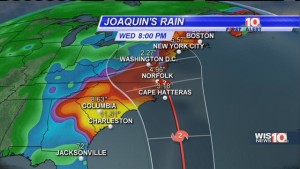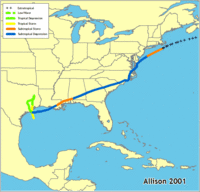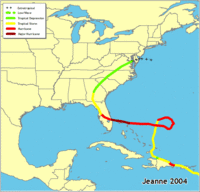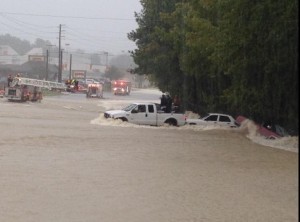Top-down processing is also known as conceptually-driven processing, given that an individual’s perceptions are influenced by expectations, existing beliefs, and cognitions. In some instances people are aware of these influences, but in other occurrences this process occurs without conscious awareness. On 2 OCT 2015, I believe that I, along with the majority of the people of Columbia South Carolina were not consciously aware of the top-down processing that we possessed; which influence the perception that we had in regards to believing that Hurricane Joaquin would not have an impact on the Midlands…
The South Carolina Emergency Management Division was paying close attention to Hurricane Joaquin, and as a result of the storm’s projected movement, key agencies in South Carolina government had been notified to be ready to respond if the need arose. http://www.wistv.com
“There’s a lot of uncertainty in the forecasts from the National Hurricane Center. We are preparing for the possibility that this storm could affect South Carolina, we’re asking residents to do the same.” http://www.wistv.com
As hurricane Joaquin approached the East Coast, many “Midlands” residents received all the weather reports and warnings. The storm’s path was meteorologically mapped, constantly updated, and broadcast just as with all other hurricanes and tropical storms that preceded Joaquin. The city of Columbia certainly understood the possibilities of what could happen from natural disasters such as hurricanes and flooding; however, for the residents of Columbia, South Carolina, that understanding was based off of previous knowledge of hurricanes such as Katrina; which wreaked havoc and caused major flooding throughout the state of Louisiana in 2005. Or even other hurricanes which were seemingly destined to make landfall and relentlessly travel across the “Lowcountry”, such as Hurricane Hugo; which severely inflicted damage to Charleston, SC and the neighboring city to Columbia, Sumter, in 1989. Also, Hurricane Jeanne in 2004 and Tropical Storm Allison in 2001 caused major flooding in South Carolina, but ironically, not in Columbia. So over the years, the people of Columbia’s understanding of these types of natural disaster somehow did not apply to the city of Columbia itself since the perception was that even though natural disasters had threatened the city in the past, some even threatened a direct impact, all the storms previously amounted to no more than dark clouds and heavy rainfall; which quickly passed through without major concern or destruction.
Despite having prior knowledge of hurricanes and flooding, Top-Down Processing hindered the ability of the Columbia, SC residents to perceive such devastation for this particular environment. Patterns of previous storms in the city, and the faint aftermath of their existence had apparently caused a perceptual set, or bias towards anything of the sort occurring in the capitol city; which limited the expectations and beliefs:
“We haven’t seen this level of rain in the Lowcountry in 1,000 years. That’s how big this is,” Gov. Nikki Haley said at a press conference Sunday afternoon. “That’s what South Carolina is dealing with right now. The Congaree River is at its highest level since 1936.” http://www.nydailynews.com
Though the warnings were given, the dark clouds quickly rolled in, and the rain poured down, what the residents of Columbia (to include myself) visualized and perceived was simply another heavy rainfall that would quickly pass. With that perception of this particular environment, obviously, not many prepared for the devastation that occurred on 3 OCT 2015. Hours into the day, the rain poured in and major roadways were starting to flood. Well into the next day the rain was still pouring in, and vehicles, homes, and apartments were flooded. Residents were being rescued from their flooding vehicles, airlift rescues were being conducted for residents stuck on the rooftops of their homes, several dams were broken within the city, major roadways and bridges were washed out, and businesses were now under water. Days later after the rain stopped, all potable water systems and electric power to the city were out. Hurricane Joaquin had taken 9 lives, and had relentlessly inflicted unimaginable havoc and loss in the city of Columbia. As of today, though power and water has been restored, the city is still in the recovery stage of restoring roadways, businesses, homes, and supplementing the financial needs of those who have lost everything and are still living in “temporary shelters.”
As previously mentioned, a determination was made about the storm unconsciously, just as with unconscious inference. The theory of unconscious inference includes the likelihood principle, which states that we perceive the object that is most likely to have caused the pattern of stimuli we have received. (Cognitive Psychology, E. Bruce Goldstein, 3rd Ed.) Thus, it was inferred that the dark clouds and heavy rain was simply a rain storm that would soon pass because of experiences we have had with similar situations in the past. As stated in the text, Helmholtz describes the process of perception as being similar to the process involved in solving a problem. As explained, for perception, the problem is to determine which object has caused a particular pattern of stimulation, and this problem is solved by a process in which the observer applies his or her knowledge of the environment in order to infer what the object might be. (Cognitive Psychology, E. Bruce Golstein, 3rd Ed.)
As the clouds and rain were identified, this process was unconscious, hence the term unconscious inference.











I agree, we have a tendency to misinterpret the amount of danger that we are in. After reading your post I did some searching and found some interesting thoughts on disaster response. I linked a few articles that I found interesting.
Our ability to reason and make decisions is what safeguards us from harmful situation. From an evolutionary perspective, our brains are designed to evaluate a situation and make the decision that best ensures long term survival. This decision may be easy when you are a neanderthal who is being stalked by a dangerous animal but in modern times these decisions can be much more difficult.
In August of 2005 Hurricane Katrina was headed towards the gulf coast. Many of the inhabitants of New Orleans live on an income that is well below the poverty line, even more live on government assistance. Tragically many of those who lost their lives simply did not have the resources to evacuate. How do you leave your home if you do not have a car or money? Many of these people feel like they did not have a choice so they resolved themselves to whatever fate was headed toward them.
In the aftermath of Katrina many people made statements that those who chose to stay were draining valuable resources or that they should have to fend for themselves. Others who had the financial means to evacuate looked at the situation from an outsiders perspective and criticized those who were left behind. The perception of those who viewed this event from the outside were much different than the actual experiences of those trapped in New Orleans. Those on the outside could not change their perceptions to understand why some made the choices that they did.
Another factor is deniability. The truth is that we all possess some level of deniability when faced with a life altering situation. In the case of Hurricane Katrina, many of the long term residents of New Orleans have seen many storms hit the gulf coast. Because nothing bad happened to them in the past they apply top- down processing and decide that they will be safe because they were safe every other time. The more times that they are faced with the decision to evacuate and are safe after they decide to stay the more likely that they are to stay the next time a big storm hits. If bottom up processing was applied to this situation, more rational decisions may have been made.
http://insight.kellogg.northwestern.edu/article/why_did_they_stay
http://vitals.nbcnews.com/_news/2012/08/30/13551209-storm-psychology-why-do-some-people-stay-behind?lite
http://www.fmglobalreason.com/article/flirting-disaster